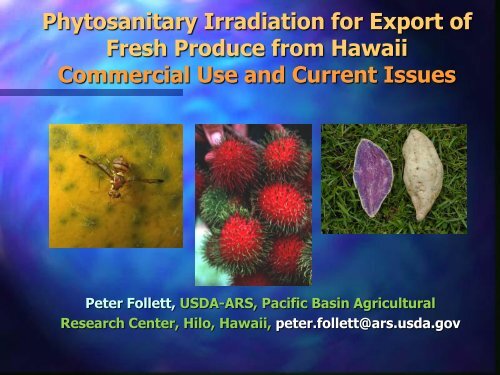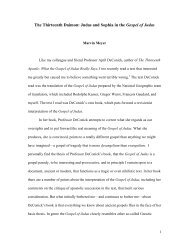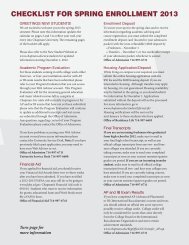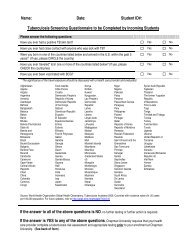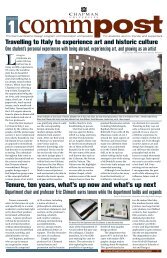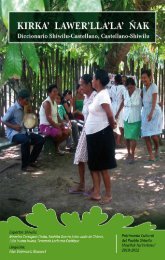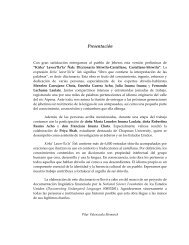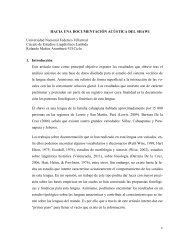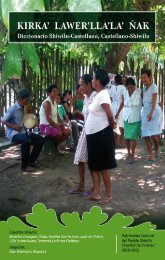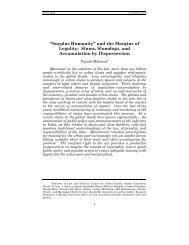Results of Invasive Species Research
Results of Invasive Species Research
Results of Invasive Species Research
You also want an ePaper? Increase the reach of your titles
YUMPU automatically turns print PDFs into web optimized ePapers that Google loves.
Phytosanitary Irradiation for Export <strong>of</strong><br />
Fresh Produce from Hawaii<br />
Commercial Use and Current Issues<br />
Peter Follett, USDA-ARS, Pacific Basin Agricultural<br />
<strong>Research</strong> Center, Hilo, Hawaii, peter.follett@ars.usda.gov
Overview<br />
• Irradiation in Hawaii<br />
advantages and drawbacks<br />
• Generic Treatments<br />
• <strong>Invasive</strong> species<br />
• Big Issues<br />
• Sweet potato irradiation<br />
Video
Phytosanitary radiation treatment<br />
Insect disinfestation<br />
• Insects • Fresh<br />
horticultural<br />
products
The Technology<br />
Gamma, e-beam, or x-ray<br />
Ionizing radiation breaks chemical bonds within<br />
DNA and other molecules, disrupting normal<br />
cellular function. Insect response varies with<br />
species and life stage.
Irradiation<br />
Hawaii Pride<br />
Surebeam, San Diego, California<br />
Opened August 2000<br />
13,600 mt capacity (30 million lbs)<br />
Electron linear accelerator 5 MeV, model<br />
TB-5/15<br />
X-ray irradiation<br />
Privately owned by Calavo Growers, Inc.
Export approvals using irradiation<br />
Hawaii: 17 fruits, 7 vegetables<br />
• Sweet potato*<br />
(12 million lbs)<br />
• Papaya*<br />
• Longan*<br />
• Rambutan<br />
• Dragon fruit<br />
• Banana*<br />
• Mango<br />
• Mangosteen<br />
• Melons*<br />
• Lychee<br />
• Carambola<br />
• Sapodilla<br />
• Jackfruit<br />
• Breadfruit<br />
• Abiu<br />
• Atemoya<br />
• Guava<br />
• Pineapple*<br />
• Capsicums*<br />
• Eggplant*<br />
• Cucurbits*<br />
• Tomato*<br />
• Cowpea*<br />
• Moringa*<br />
* year-round<br />
Hawaii Pride<br />
Kea’au, HI
Hawaii Pride X-ray Irradiator
Irradiation<br />
Drawbacks<br />
• Not organic<br />
• Not accepted everywhere,<br />
e.g. Japan,<br />
Taiwan, Europe<br />
• Anti-irradiation<br />
groups<br />
• Labeling and signage<br />
(FDA rule pending)<br />
• 1 kGy limit<br />
• High initial costs<br />
• 12-months <strong>of</strong> product<br />
Pseudo-drawback<br />
• Acute mortality is low<br />
• “Live” pests after<br />
treatment, but nonviable<br />
• Effective if it prevents<br />
reproduction<br />
• Inspection is<br />
redundant
Irradiation<br />
Advantages<br />
• Broadly effective<br />
• Good product<br />
tolerance<br />
• Extend shelf-life<br />
• Competitive cost<br />
• Treatment is fast<br />
• Treat in final<br />
packaging<br />
• Alternative to<br />
MeBr<br />
• Generic treatments
Generic Radiation Treatments<br />
Pioneering rule<br />
• USDA-APHIS approval January 27,<br />
2006<br />
• Tephritid fruit flies – 150 Gy<br />
• All other insects – 400 Gy<br />
(except Lepidoptera pupae and adults)<br />
• Fresh fruits, vegetables, and cut<br />
flowers and foliage
Generic Doses<br />
International use<br />
India, Pakistan – mango, pomegranate – 400 Gy<br />
Thailand – 6 tropical fruits – 400 Gy<br />
Vietnam – dragon fruit – 400 Gy<br />
Mexico – mango, guava, citrus, carambola – 150<br />
or 400 Gy<br />
Malaysia – papayas – 400 Gy<br />
Vietnam – rambutan – 400 Gy<br />
South Africa – sweet cherries, apricot, plucot,<br />
table grapes, lychee – 400 Gy
<strong>Invasive</strong> species research<br />
Melon fly 3 rd instars
Generic doses – next steps<br />
Why lower the dose?<br />
• Use <strong>of</strong> 400 Gy generic dose is<br />
most common – during treatment<br />
some fruit may receive 700-800<br />
Gy!<br />
• Close to phytotoxic threshold for<br />
many commodities<br />
• If dose can be lowered, will help<br />
ensure high quality is maintained<br />
• And, will lower costs and increase<br />
capacity
Hawaii irradiation research<br />
Establishing safe doses<br />
Pest<br />
Fruit flies (3)<br />
Sweet potato pests (3)<br />
Mango seed weevil<br />
Litchi fruit moths (2)<br />
Armored scales (2)<br />
Banana moth<br />
Ants (2)<br />
Light brown apple moth<br />
Spotted wing drosophila<br />
European grapevine moth<br />
Irradiation dose (Gy)<br />
150<br />
150<br />
300<br />
250<br />
150<br />
150<br />
100<br />
150<br />
40-50<br />
in progress
Light brown apple moth*<br />
New pest<br />
• Native to Australia<br />
• Since 2006,<br />
spreading in<br />
California<br />
• Regulated pest in<br />
Canada, Chile, Korea,<br />
Mexico, Peru, Thailand,<br />
and South Africa<br />
• Leafroller, but may<br />
feed on fruit surface<br />
• All stages: irradiated at<br />
0, 30, 60 ,<br />
90, 120, and<br />
150 Gy<br />
• 5 th instars: 35,000<br />
tested at 150 Gy with no<br />
adult emergence<br />
• Pupae: 300-400 Gy
Spotted wing drosophila*<br />
New pest<br />
• Native to Southeast<br />
Asia, found in 2008<br />
• Attacks berry crops,<br />
grapes and stone fruits<br />
• Australia, New Zealand<br />
and Mexico restrict fruit<br />
from infested areas<br />
• Feeds on fruit pulp,<br />
introduces rots, 10<br />
gens/yr<br />
• All life stages irradiated<br />
at 0, 20, 30, 40,<br />
and 50 Gy<br />
• Pupae most tolerant<br />
stage in fruit<br />
• 40-50 Gy applied to<br />
pupae causes sterility as<br />
adults
European grapevine moth*<br />
New pest<br />
• Native to southern Italy<br />
• Discovered in Napa<br />
vineyards in 2009<br />
• APHIS quarantine<br />
restrictions, exports<br />
fumigated with MeBr<br />
• Webs and feeds within<br />
grape bunches, 3<br />
gens/yr, introduces<br />
Botrytis<br />
• <strong>Research</strong> forthcoming<br />
• USDA APHIS-Otis lab<br />
has a EGVM colony<br />
• They will follow methods<br />
developed for LBAM
Big Issues<br />
1 kGy limit<br />
Europe, Japan, Taiwan, etc.<br />
Labeling – phytosanitary vs. sanitary<br />
MAP packaging…<br />
Non-regulated imports Arnold Hara, Univ. Hawaii<br />
Potato psyllid
Pa’ina Hawaii<br />
Michael Koehn<br />
•At old Del Monte<br />
pineapple canning site<br />
on Oahu<br />
•Genesis irradiator -<br />
cobalt source<br />
•Scheduled start<br />
summer 2012<br />
•Sweet potato, papaya,<br />
herbs


